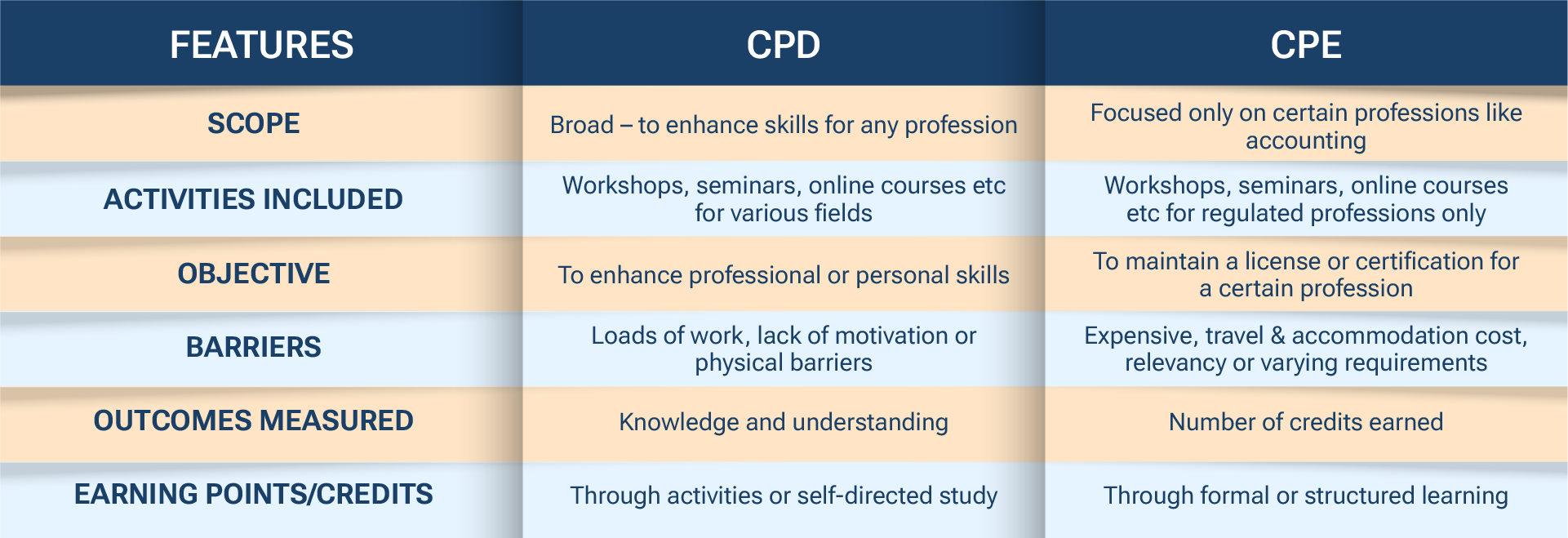Have you ever felt somewhat confused by the acronyms CPD and CPE? Both terms are sometimes used interchangeably. But the real question is – What do they mean and is there a difference between them?
In this blog, we have outlined the differences to help professionals clarify any confusion these acronyms may create.
What is Continuing Professional Development (CPD)?
Continuing Professional Development (CPD) refers to the ongoing investment professionals make in their knowledge, skills, and competencies to enhance career progression and maintain industry relevance. CPD encompasses a range of learning activities, including seminars, webinars, and conferences, enabling professionals to stay updated with evolving industry standards and best practices.
What is Continuing Professional Education (CPE)?
Continuing Professional Education (CPE) is a structured learning requirement for regulated professions, ensuring professionals maintain and enhance their expertise through ongoing education. CPE is mandatory for individuals in specific fields to retain their professional registration or licensure, ensuring compliance with industry regulations and competency standards.
Scope of CPD vs CPE
CPD (Continuing Professional Development) encompasses various activities designed to help professionals enhance their skills and knowledge throughout their careers. It includes formal and informal learning experiences such as workshops, conferences, self-directed activities like reviewing books and reading articles or journals.
In contrast, CPE (Continuing Professional Education) refers exclusively to formal learning, typically required by certain professions, such as law, nursing, or accounting, to ensure professionals remain up to date with regulations, requirements, and industry standards, thus maintaining their licenses or certifications.
How are the outcomes of Continuing Professional Development (CPD) and Continuing Professional Education (CPE) measured?
CPD outcomes are measured by CPD credits or points, the number of hours spent on a CPD activity. Its impact is usually measured through the knowledge and understanding gained via CPD events or activities and to record CPD credits or points, the CPD log is structured way.
Similarly, the outcome of CPE is primarily measured by the number of credits earned. Professionals can show completion via certificates or documents proving they have fulfilled the credit hours mandated by professional regulations.
Key Differences Between CPD and CPE
There are several key distinctions between CPD and CPE, including scope, activities, objectives, learning outcomes, barriers, and credit or points, as outlined below:
Challenges in pursuing CPD or CPE
Both CPD and CPE present challenges for many professionals, often due to time constraints, demanding work schedules, and other obstacles that hinder participation in development activities.
- Time and Workload Constraints: For professionals, such as teachers, finding time for CPD can be a significant challenge. Teachers often juggle heavy workloads and cannot easily carve out time for additional learning activities. This can make it difficult for them to engage in professional development activities.
CPE, on the other hand, is typically a mandatory requirement for regulated professions such as law, nursing, and accounting. These professionals are required to complete specific CPE activities to maintain licensure, the time commitment can still pose a challenge, particularly for those balancing tight schedules with ongoing work responsibilities. - Lack of Self-Motivation: Another barrier for both CPD and CPE, professionals may experience burnout, especially if their workload is overwhelming, leaving them with little energy or enthusiasm for engaging in further learning. This is especially true for CPD, which is generally voluntary. For CPE, the situation can be more complex. Although it is a requirement for regulated professions, professionals who are overwhelmed by their primary responsibilities may still feel demotivated or disconnected from the CPE process. The pressure of balancing mandatory learning with job demands can lead to disengagement.
- Financial constraints: Participating in CPD or CPE often involves costs. For CPD, workshops, conferences, and resources like books or courses may be financially inaccessible for some professionals, leading to financial constraints. Additionally, events that are held in distant locations add to the burden of travel and accommodation expenses.
CPE, however, generally presents higher financial barriers due to its mandatory nature. The required hours for certification or licensure can result in significantly higher costs, especially when travel to specialised programmes is necessary. - Flexibility: CPD is generally more flexible than CPE. CPD activities can include both formal and self-directed learning, making it possible for professionals across industries to tailor their development to fit their schedules and interests.
In contrast, CPE is often more rigid, as it is typically required by specific regulatory bodies. Professionals need to follow specific CPE guidelines to maintain their certifications. This mandatory nature can limit flexibility, as professionals may be forced to choose from a set of approved programmes rather than selecting learning activities that are directly relevant to their own needs. - Finding Relevant Sources: Both CPD and CPE can present difficulties in terms of finding suitable learning opportunities. For CPD, the challenge lies in the abundance of options available. Professionals may struggle to identify which activities are most relevant or beneficial to their career growth. For CPE, the limited availability of approved programmes and regulatory requirements set out by professional bodies make it difficult to find opportunities that meet specific needs or preferences.
- Varying Requirements: Another challenge with CPE is the variety of requirements set by different regulatory bodies. Professionals in certain fields may face confusion regarding which CPE activities meet the necessary criteria to maintain their certification. Not all CPE programmes provide the depth or insight that professionals need to meet the standards set by their regulatory bodies, which can make it difficult to choose the right programmes.
CPD, in contrast, offers more flexibility. Since it is not tied to a specific licensure or certification, professionals have more autonomy in deciding what types of learning activities to pursue, based on their career interests and development goals.
Earning CPD and CPE Points
CPD and CPE are both systems to earn certain points or credits that show professional ongoing learning.
CPD points can be earned through a range of activities like seminars, conferences or self-directed study. These activities only aim to broaden your professional skillset and knowledge.
On the other hand, CPE points are earned through a more formal and structured way of learning like formal courses, conferences or other events. These activities directly focus on enhancing the skills and understanding within a specific field or subject.
CPD or CPE: Which Path is Right for You?
Choosing between Continuing Professional Development (CPD) and Continuing Professional Education (CPE) depends on your industry, career goals, and professional requirements. Here’s a breakdown to help you decide:
Assess Your Career Goals: If you are in a regulated profession where maintaining licensure is crucial (like accounting), then pursuing CPE is essential.
If you are looking for broader career advancement opportunities or transitioning into different roles or industries, then CPD may be more suitable.
Consider Your Current Role: Evaluate whether your current position requires specific certifications that necessitate CPE credits.
If your role allows for flexibility in skill enhancement without strict regulatory oversight, consider engaging in CPD activities that align with your interests and career aspirations.
Evaluate Industry Trends: Research trends within your industry to determine whether there is a growing emphasis on formal qualifications (favouring CPE) or if there is an increasing value placed on diverse skill sets (favouring CPD).
Can You Pursue Both?
Absolutely! Many professionals blend CPD and CPE to maintain regulatory compliance while also expanding their skills beyond formal education. For example, an accountant may complete CPE credits for licensure while engaging in CPD activities to develop leadership and business strategy skills.
Conclusion
Continuing Professional Development (CPD) and Continuing Professional Education (CPE) both are important for ongoing learning; however, there are major differences.
CPD includes a range of both formal and informal activities required to enhance personal or professional skills. CPD is not mandatory and anyone can participate in CPD events as they see fit. On the contrary, CPE includes only formal activities or events and is mandatory for professionals to show evidence of CPE points earned via these activities. CPE helps professionals to maintain their certification, licensure or registration.
Both paths offer valuable opportunities for growth; however, aligning them with your specific circumstances will yield the best outcomes for your career trajectory.


























